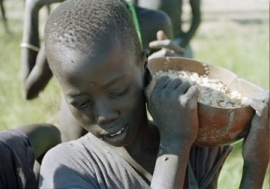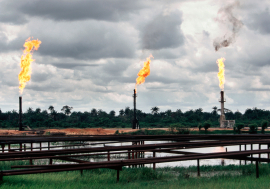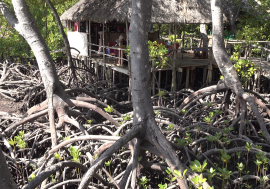Africa seeks fair share of ‘green’ cash
One of the great challenges facing scientists and political leaders in combating global warming is a difficulty that is, well, global. At first glance, that would not seem to be a problem at all. The fact that pollution released in the US or Europe is changing, sometimes disastrously, the climate of people thousands of kilometres away in Africa or Asia should bring the world together. After all, everyone is in the same ecological boat.
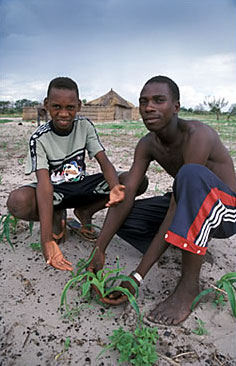 Replanting a maize field after a prolonged drought in Zambia: Climate change is hitting Africa especially hard.
Replanting a maize field after a prolonged drought in Zambia: Climate change is hitting Africa especially hard.The catch is that not all countries contribute to or are affected by climate change in the same way. The industrial “greenhouse” gases that contribute to climate change, including carbon dioxide, come mostly from wealthy industrialized countries or rapidly growing economies, such as those in China and India. Poor developing countries without much industry, as in Africa, contribute little to the problem — but are hurt by it nonetheless. As Rajendra Pachauri, head of the UN Intergovernmental Panel on Climate Change, notes, the poor “are certainly going to be the worst sufferers,” since they and their societies lack the money and technology to adapt.
Responsibility for climate change was an issue in the negotiations for the 1997 Kyoto Protocol, which requires polluters to cut their greenhouse gas emissions. Poor countries argued that they should not be penalized for problems caused by the rich. They called for negotiators to find ways to encourage wealthy countries to assist the poor with modern “green” technology and to help them cope with the effects of climate change. They also urged a balance between trying to reduce emissions and encouraging economic development, so as to lift billions of people in the developing South out of poverty.
Clean Development Mechanism
The solution to this looming North-South divide was found in the notion of “common but differentiated responsibility.” Under that concept, all countries accept the obligation to combat global warming, but they do so within their means. At Kyoto, most developed countries agreed to cut their emissions to 5 per cent below 1990 levels, while at the same time exempting developing countries from mandatory reductions. They also agreed to an innovative financing measure called the Clean Development Mechanism (CDM). Its purpose is to reduce the cost of cutting emissions in the North while helping developing countries finance their own clean energy projects.
The CDM is a private-sector initiative that allows businesses in developed countries to meet part of their domestic emissions targets by financing emissions-reducing projects in developing countries, where costs are often lower. A European company required by its government to reduce greenhouse gas discharges by 100,000 tonnes per year, for example, might find it cheaper to upgrade a polluting coal-burning power plant in India than to modernize its factory at home. The CDM allows that company to count the pollution averted in India against its 100,000-tonne target.
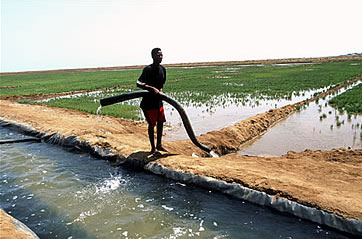 Irrigation canal in Eritrea: The CDM’s current rules do not favour financing projects to help Africa adapt to climate change, such as irrigation schemes.
Irrigation canal in Eritrea: The CDM’s current rules do not favour financing projects to help Africa adapt to climate change, such as irrigation schemes.Such CDM-approved projects are assigned one “carbon emission reduction” credit (CER) for every tonne of greenhouse gas they save. CERs in turn can be sold on one of several international carbon exchanges — for instance, to a steel company in Germany, a cement factory in Sweden or a power plant in the UK, to help those countries meet their emissions-reduction requirements.
Cleaner power in Uganda
The possibilities of the CDM are great on a continent where population growth, climate change and lack of investment have contributed to chronic shortages of energy. For the residents of Uganda’s rural West Nile region, generating energy for cooking, lighting and commerce was an expensive, dirty and sometimes frustrating experience until recently. Most households used kerosene or wood for day-to-day needs, while local businesses and the better off bought their own generators and diesel fuel for electricity, as the area was too remote and thinly settled to warrant connection to the national power grid. Kerosene and diesel had to be trucked in from distant depots over poor roads, adding to the cost and making supplies erratic.
The solution was to install a small hydroelectric plant on the nearby Nyagak River. But that too presented problems. Local authorities lacked the engineering, management and financial skills to design and implement the project. And its small size — it served just 4,000 homes — made it unattractive to private investors in the absence of outside funding.
Yet because the project would prevent the release of about 36,000 tonnes of greenhouse gases per year, compared with existing energy sources, it qualified for inclusion in the CDM. With technical help from the Ugandan government and financial assistance from Finland and the Netherlands, the project received final approval by the CDM in 2005. The resulting CERs generated annually are sold on world carbon markets to help defray construction and operating costs — contributing to clean and sustainable development in Uganda and cheaper compliance with the Kyoto Protocol for buyers in the North.
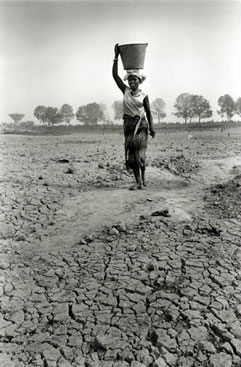 A dried up river bed in Mali.
A dried up river bed in Mali.For Africa and other poor regions struggling to cope with climate change, such financing is vital. Scientists argue that global warming is damaging Earth’s climate faster than expected, and a severe shortfall in funds is hampering African efforts to cope.
Unfortunately, the success of the West Nile CDM project is the exception rather than the rule in Africa. According to researchers for the UN Framework Convention on Climate Change (UNFCCC), which oversees the CDM, Africa accounts for only about 3 per cent of the more than 1,000 CDM-approved projects globally — and half those are in South Africa, where sophisticated industrial and financial infrastructure lends itself to the complex CDM approval process. The rest of sub-Saharan Africa accounts for just a handful of CDM projects.
Poor business climate
Africa’s difficulties in attracting CDM projects are similar to those that have hampered the continent’s efforts to land purely commercial investments. Those include a lack of infrastructure and skilled labour, high poverty rates, limited financial resources, a shortage of the management and technical skills needed to meet CDM standards, weak institutions, corruption and political instability. Together, such shortcomings have saddled the region with a reputation as a difficult place to do business.
Many African governments and environmentalists also note that the CDM’s rules favour pollution-reducing projects rather than those that could help Africa cope with climate changes, such as irrigation schemes, soil conservation and flood-control programmes. Such projects were instead to be met by the Kyoto Protocol’s Adaptation Fund, financed in part by a 2 per cent levy on CDM credits.
The slow pace of approvals is another problem. The World Bank noted in a 2008 report that while CDM regulators have signed off on some 1,000 projects since the mechanism was launched in 2005, an additional 2,000 projects are still under evaluation, creating delays and discouraging investors.
CDM officials told Africa Renewal that efforts are underway to streamline application procedures and speed up the approval process. But they also said that the time-consuming vetting proposals undergo is necessary if the CDM is to be a credible tool for greenhouse gas reductions.
Although CDM credits are not the only kind traded on world carbon markets, they are coveted for their quality and fetch higher prices. Before qualifying for CDM credits, projects must demonstrate that they are compatible with sustainable development plans by the host country, that they will produce verifiable emissions reductions and that they would not be built without the added financing of emissions credits, a requirement known as “additionality.” Only after such conditions are met are credits issued, a process that can take up to two years.
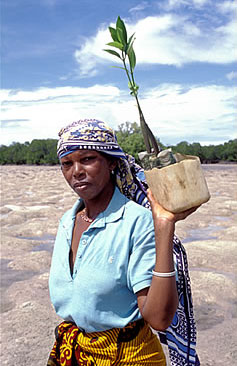 Carrying a tree seedling at a mangrove rehabilitation project in Kenya. Africa’s difficult investment climate makes it hard to attract private financing for sustainable development initiatives.
Carrying a tree seedling at a mangrove rehabilitation project in Kenya. Africa’s difficult investment climate makes it hard to attract private financing for sustainable development initiatives.According to the World Bank, in 2007 the CDM generated some $13 bn in emissions credit sales, part of an overall carbon market worth $64 bn — more than double the size of the market the previous year. CDM spokesman David Abbass told Africa Renewal that with world carbon markets projected to generate $100 bn by 2012, the year the Kyoto Protocol expires, it is vital that Africa attract its fair share.
“The accelerating growth of carbon markets resulting from the UN-brokered climate change agreement,” the head of the UN Environment Programme, Achim Steiner, told a meeting of African bankers in May 2007, “represents a significant economic and development opportunity for Africa.”
Nairobi Framework
In late 2006, a coalition of UN and development agencies, including the UN Environment Programme, the UN Development Programme, the UNFCCC Secretariat, the World Bank and the African Development Bank, launched an initiative to help Africa take greater advantage of the CDM. Known as the Nairobi Framework and inaugurated by then UN Secretary-General Kofi Annan, the initiative initially is focusing on:
- Building local and national technical capacity to design and implement CDM projects
- Expanding awareness of CDM opportunities among African and international government and private-sector leaders
- Encouraging greater cooperation among African governments in attracting green investments
- Strengthening coordination among governmental and non-governmental agencies to streamline and shorten project timelines and approval delays.
In 2007 the Framework launched an Internet-based CDM Bazaar to bring project developers together with investors; to provide a venue for engineers, marketing firms and other service providers; and to highlight the opportunities for CDM activities in Africa and other developing areas. The Framework will convene an all-Africa carbon forum in Senegal in late 2008 to further highlight the potential of Africa for green development investors.
Efforts are also underway to reform the CDM’s rules. At a December 2007 climate change meeting in Bali, governments agreed to explore ways to expand the CDM into areas previously excluded from eligibility, such as forest preservation, and to simplify application and compliance rules. The World Bank is expanding its efforts to promote CDM projects in developing countries by launching a guarantee programme to reassure Northern investors of the security of African CERs, and buying and selling carbon credits itself (see box).
Impatience mounts
But with an ambitious 2009 deadline for agreement on a successor treaty to the Kyoto pact, there are fears that developing countries will balk at stronger action against climate change if they feel they have been short-changed by the current accord.
Addressing the UN climate meeting in Bali on behalf of the African delegations, the Nigerian government pointedly noted that funds to help Africa cope with climate change often come with conditions governments find difficult to meet, and that international “capacity-building” programmes produce little in the absence of resources. “There is too much emphasis on seminars, workshops and needs assessment,” the government stated. “For how long will our needs continue to be assessed?” In the meantime, it concluded, “The suffering of our people continues.”
The man charged with guiding negotiations for a successor to Kyoto, UNFCCC head Yvo de Boer, told a reporter for US News and World Report in early 2008 that a North-South split over climate change is the single greatest threat to progress. “On the one hand the question: Will rich nations really show the type of leadership required for poor countries to engage,” he said. “Secondly, can we mobilize the finance and technology that will make it possible for developing countries to engage?”
Developing countries are willing to join the industrialized world in limiting emissions, Mr. de Boer continued, “but for them to do that, technology, financial resources and capacity-building have to be provided by rich nations.” Accommodating the interests of rich and poor, he added, “will require striking a delicate balance.”
Marshall Plan needed
In the view of some of Africa’s leading climate scientists and environmental officials, far more needs to be done to match the continent’s needs with resources. Richard Muyungi, deputy director for the environment in the office of the Tanzanian vice-president, told Africa Renewal that the cost of climate change in that East African country, among the world’s poorest, is already running into the billions of dollars and slowing economic growth.
“Our energy sector has been most affected,” Mr. Muyungi said. He noted that drought has sharply reduced reservoir levels for hydroelectric power, causing difficulties throughout the economy. “Many of our coastal islands are threatened by rising sea levels” from melting polar icecaps, he explained, while higher temperatures on land are imposing costly new demands on the national health system. “We now have malaria around Mt. Kilimanjaro” as a result of climate change, he observed. “We never had that before.”
The severity of the drought, and mounting concerns about the impact of climate change on food prices, Mr. Muyungi said, have already forced the government to shift spending from long-term sustainable development programmes to emergency relief. It has also had to downgrade its earlier estimate of 6–7 per cent economic growth for 2008. “We cannot estimate the total cost, as we don’t know how severe the impact will be. It is already impossible to grow cotton and maize in some areas. How much the losses will be is harder to say.”
Tanzania is collaborating with UN agencies and bilateral donors to develop a national climate change action plan and is working within the Nairobi Framework to attract CDM funding, Mr. Muyungi explained. “But the procedures are too complicated. Africa is already behind in terms of foreign direct investment and the same problems stand in the way of CDM projects.” The CDM needs a much more comprehensive and strategic approach to Africa, he concluded, if it is going to help the region cope. “We really need a Marshall Plan.”
Reforming the system
Ogunlade Davidson, co-chair of the working group on greenhouse gas reductions of the UN intergovernmental climate change panel and dean of postgraduate studies at the University of Sierra Leone, is even blunter. The CDM, he told Africa Renewal, has been “hijacked” by the private sector and transformed into a profit-generating centre instead of a vehicle for greenhouse gas reductions.
Under the current system, Mr. Davidson says, investors are able to “piggyback” carbon emissions credits onto commercial projects in countries like China and India that are already attracting high levels of foreign investment. That is one reason so many CDM projects are located in industrializing developing countries, he declares, and so few in sub-Saharan Africa.
Even more alarming, Mr. Davidson observes, is the failure of the CDM rules to require domestic greenhouse gas reductions in developed countries, which are the largest buyers of carbon credits. “It’s a major flaw. Developed countries need to reduce their emissions by 90 per cent. We need more drastic action. Market forces alone cannot deliver the emissions reductions that are needed. Markets caused the problem in the first place.”
The CDM can be improved through reform of its procedures, tighter requirements for domestic emissions reductions and expansion of the kinds of projects eligible for financing, Mr. Davidson says. The mechanism also needs to be supplemented with new instruments, such as a protocol to make advanced technologies available to developing countries at discounted rates, government action to raise the cost of greenhouse emissions to encourage domestic reductions and more funding for the Adaptation Fund.
A 2 per cent levy on even $100 bn in annual sales of carbon credits, he points out, would only generate $2 bn a year — not nearly enough to make a difference. “The requirement is huge,” he emphasizes. “Most adaptation finance will have to come via development aid. It must become mainstreamed into the development process.”
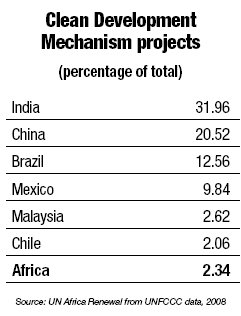
Capacity building programmes like those offered by the Nairobi Framework are also necessary, he adds, but should be channelled into existing African science-and-technology and management training institutions.
NEPAD: mainstreaming green
Integrating climate change and environmental protection into African development programmes is central to the environmental action plan of the New Partnership for Africa’s Development (NEPAD), the pan-African blueprint adopted in 2001. The environment plan, launched in 2003, sets three broad priorities for African governments and their development partners:
- Identification of the regions and people most vulnerable to climate shocks and creation of monitoring and early-warning systems
- Formulation of detailed national and regional response plans, including disaster emergency measures, flexible development programmes and long-term coping strategies
- Acquisition of practical experience through demonstration and pilot projects to “show the way forward” in sustaining economic development while simultaneously adapting to climate shocks.
To date, about two dozen African countries have developed national climate change action plans, and NEPAD-supported programmes to combat the expansion of the Sahara Desert and protect the forests of Central and West Africa are beginning to show results. Many of NEPAD’s other proposals, including the construction of a continental electricity grid, would also go far towards “greening” Africa’s development and easing poverty.
But for now, many NEPAD projects remain outside the scope of global climate funding, and promised increases in Northern development aid for Africa have not materialized. Until financing is found, many of NEPAD’s green development plans will remain on the shelf and Africa’s ability to cope with climate change will be limited.
‘Pollution permit’?
Concerns about the economic and environmental effectiveness of carbon trading as a weapon in the fight against climate change are not limited to Africa. Many environmental activists and some economists have opposed carbon trading on principle. They argue that allowing polluting industries in developed countries to count emissions credits against their mandatory reduction quotas constitutes a market in “pollution permits” and undermines incentives for the industrial North to make the deep cuts necessary to halt global warming.
Uncertainty about the shape of a post-Kyoto climate pact is also roiling the carbon markets. Business analysts predict that investors are likely to reduce their purchases of credits until there is greater clarity about the future. This is likely to depress world prices for carbon credits at a time when many climate scientists argue that prices are already too low to provide strong financial incentives to cut emissions in industrialized countries.
For Africa, however, fixing the market’s flaws may be less urgent than finding a way into it. “When Africa only has 30 CDM projects out of 1,000,” Mr. Muyungi noted drily, “there is a problem.”
World Bank climate funds under fire
The World Bank is moving aggressively into the booming global trade in pollution credits that are intended to help reduce the amount of industrial greenhouse gases, often called carbon emissions, that contribute to global warming. Since the launch of the Bank’s pilot Prototype Carbon Fund in 1999, the institution has been operating or managing 10 separate carbon-trading facilities, including:
- The Community Development Carbon Fund to finance small-scale clean energy projects
- The BioCarbon Fund to invest in forestry and agriculture projects that absorb and sequester greenhouse gases
- The Umbrella Carbon Fund, which pools financing for purchases of credits from large emissions-reductions projects
- The Carbon Fund for Europe, a joint venture with the European Investment Bank
- The national carbon funds of Spain, Italy and Denmark, and two funds for the Netherlands.
At the end of 2007 the Bank announced plans for two more funds: a Carbon Partnership Facility to coordinate emissions-trading projects with national and regional development programmes and a Forest Carbon Partnership Facility to finance preservation of existing forests in developing countries. This growing stable of funds, says the Bank, is “building opportunities for developing countries to access carbon finance in support of low-carbon development goals.”
The Bank has also proposed that it manage another two funds to be financed largely by the US, UK and Japan. One would underwrite clean technology transfer and the other would fund climate change adaptation in developing countries. These funds would have assets of $5–11 bn, dwarfing other UN climate change resources and making the Bank the largest single source of climate financing. The proposal was made at a meeting of the “Group of 20” largest economies that was held outside Tokyo in March.
Stiff opposition
But the proposals have encountered stiff opposition from developing countries and non-government environmental organizations, which argue that the funds will come at the expense of UN climate efforts, duplicate existing institutions and impose additional donor conditions on developing countries.
Ms. Bernaditas Muller, a Philippines government official and representative of the developing nations’ Group of 77, argued that the funds are “outside” the agreed UN climate convention and would “undermine the efforts at the convention on climate resources.” She called instead for donor funds to be channeled through UN climate change bodies, which she argued are more representative.
South African Environment Minister Marthinus van Schalkwyk complained that developing countries have been kept in the dark about the new funds. South Africa sees no reason to establish “piecemeal” parallel financing streams outside the UN, he said. “We prefer not to have a proliferation of funding from other multilateral agencies.” He also demanded assurances that donor contributions would represent additional resources, not money reprogrammed from existing development aid budgets.
‘Potentially detrimental’
The Indian government described the funds as “potentially detrimental” to the fight against climate change. The multilateral financial institutions have “asymmetrical governance structures” in which donors exercise greater control. As a result, “parallel funding channels could further marginalize developing countries from having a stake in the fight against climate change.”
Since then, World Bank spokesman Roger Morier told Africa Renewal, the Bank has substantially revised the original proposals, most importantly by diluting donor control of the funds’ boards of directors by allocating an equal number of seats to developed and developing countries. The move has won qualified praise from some critics, including the development group Oxfam International.
But recent reports that some UK contributions to the funds will be in the form of loans instead of grants, possibly adding to future debt burdens, and continued concerns about funding streams outside the agreed UN climate framework seem likely to keep the proposals controversial. In early June a coalition of 121 non-government environmental and development groups termed loans to poor countries for climate change programmes “highly inappropriate.” They noted that “rich countries are overwhelmingly responsible for climate change” and should therefore bear the costs. A final decision on the funds is expected later in 2008.









